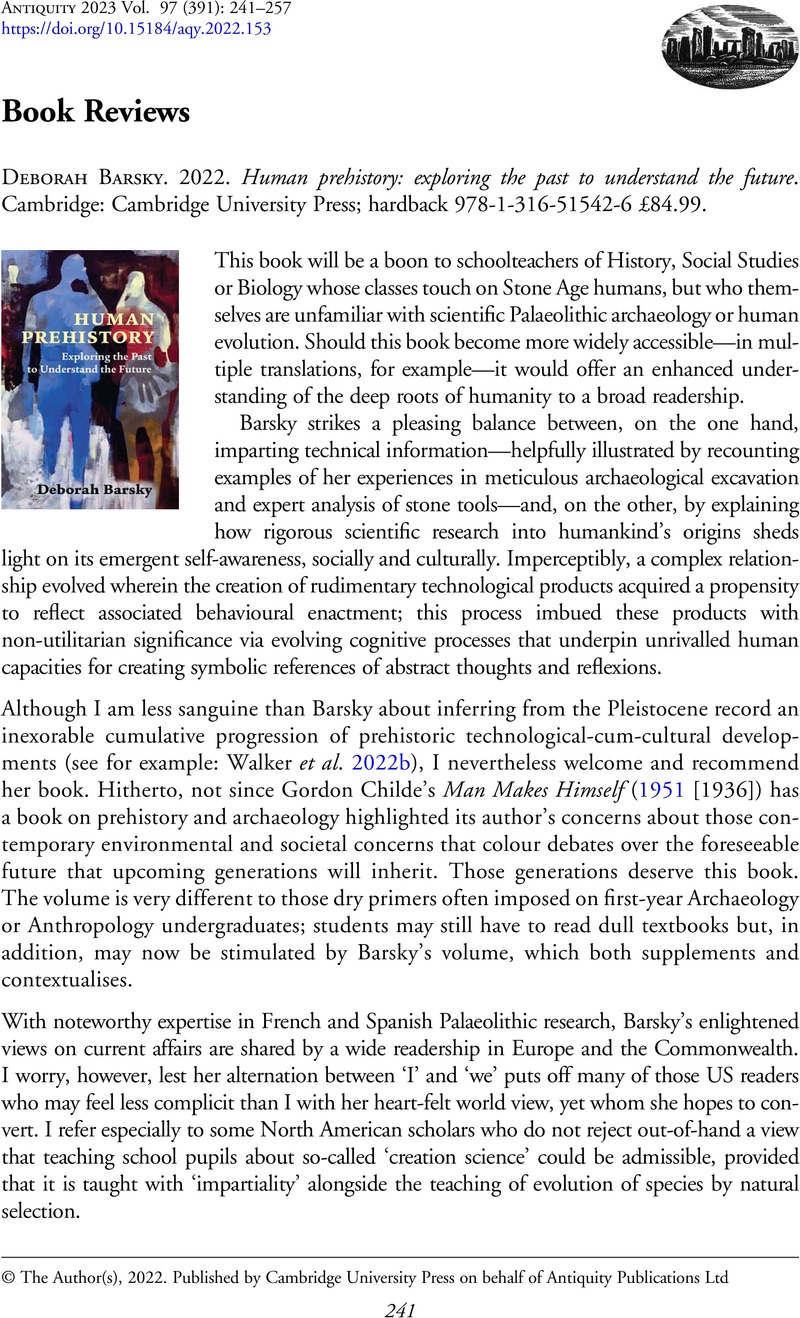No CrossRef data available.
Article contents
Deborah Barsky. 2022. Human prehistory: exploring the past to understand the future. Cambridge: Cambridge University Press; hardback 978-1-316-51542-6 £84.99.
Review products
Deborah Barsky. 2022. Human prehistory: exploring the past to understand the future. Cambridge: Cambridge University Press; hardback 978-1-316-51542-6 £84.99.
Published online by Cambridge University Press: 21 November 2022
Abstract
An abstract is not available for this content so a preview has been provided. Please use the Get access link above for information on how to access this content.

- Type
- Book Reviews
- Information
- Copyright
- Copyright © The Author(s), 2022. Published by Cambridge University Press on behalf of Antiquity Publications Ltd
References
Childe, V.G. 1951 [1936]. Man makes himself (Thinker's Library 87). London: Watts & Co.Google Scholar
Gibert, J. et al. 1999. Molar tooth fragment BL5-0: the oldest human remain found in the Plio-Pleistocene of Orce (Granada province, Spain). Human Evolution 14: 3–19. https://doi.org/10.1007/BF02436193CrossRefGoogle Scholar
Linares Matás, G.J. et al. 2021. Hyaenas and early humans in the latest Early Pleistocene of south-western Europe. Scientific Reports 11: 24036. https://doi.org.10.1038/s41598-021-03547-7CrossRefGoogle ScholarPubMed
López Jiménez, A., Uriarte, M. Haber, Martínez, M. López & Walker, M.J.. 2020. Small-mammal indicators of biochronology at Cueva Negra del Estrecho del Río Quípar (Caravaca de la Cruz, Murcia, SE Spain). Historical Biology 32: 18–33. https://doi.org/10.1080/08912963.2018.1462804CrossRefGoogle Scholar
Ribot, F. et al. 2015. Two deciduous human molars from the Early Pleistocene deposits of Barranco León (Orce, Spain). Current Anthropology 56: 134–42. https://doi.org/10.1086/679615CrossRefGoogle Scholar
Toro-Moyano, I. et al. 2013. The oldest human fossil in Europe, from Orce (Spain). Journal of Human Evolution 65: 1–9. https://doi.org/10.1016/j.hevol.2013.01.012CrossRefGoogle ScholarPubMed
Walker, M.J. et al. 2016a. Combustion at the late Early Pleistocene site of Cueva Negra del Estrecho del Río Quípar (Murcia, Spain). Antiquity 90: 571–89. https://doi.org/10.15184/aqy.2016.91CrossRefGoogle Scholar
Walker, M.J. et al. 2016b. A view from a cave: Cueva Negra del Estrecho del Río Quípar (Caravaca de la Cruz, Murcia, southeastern Spain). Reflections on fire, technological diversity, environmental exploitation, and palaeoanthropological approaches. Human Evolution 31: 1–67. https://doi.org/10.14673/HE2016121014Google Scholar
Walker, M.J. et al. 2020. Cueva Negra del Estrecho del Río Quípar: a dated Early Pleistocene Palaeolithic site in southeastern Spain. Journal of Palaeolithic Archaeology 3: 816–55. https://doi.org/10.1007/s41982-020-00062-5CrossRefGoogle Scholar
Walker, M.J. et al. 2022a. Cueva Negra del Estrecho del Río Quípar: comings and goings recorded in a late Early (Lower) Pleistocene microstratigraphical palimpsest. L'Anthropologie 126: 102995. https://doi.org/10.1016/j.anthro.2021.102995CrossRefGoogle Scholar
Walker, M. J., Manrique, H.M & Friston, K.. 2022b. Snakes and ladders in Paleoanthropology: from cognitive surprise to skillfulness a million years ago. https://doi.org/10.31234/osf.io/9rkghGoogle Scholar


